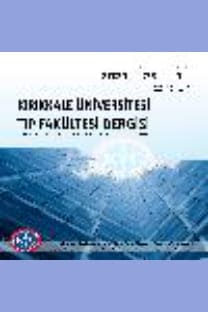BEDEN BAĞIŞI VE ANATOMİ EĞİTİMİNDEKİ ÖNEMİ
kadavra, beden bağışı, anatomi, tıp eğitimi
Body Donation and its Importance in Anatomy Education
cadaver, body donation, anatomy, medical education,
___
- 1. Zhang L, Wang Y, Xiao M, Han Q, Ding J. An ethical solution to the challenges in teaching anatomy with dissection in the Chinese culture. Anat Sci Educ. 2008;1(2):56-9.
- 2. Anyanwu GE, Ugochuckwu AI. Impact of the use of cadaver on student’s ability to pass anatomy examination. Anatomy. 2010;4:28-34.
- 3. Ganguly PK, Chan LK. Living anatomy in the 21st century: how far can we go? South East Asian J Med Educ. 2008;2(2):52-7.
- 4. John CM, John B, Paul B, Judy S. Teaching anatomy without cadavers. Med Educ. 2004;38(4):418-24.
- 5. Herrmann JR. Use of the dead body in health care and medical training: mapping and balancing the legal rights and values. Eur J Health Law. 2011;18(3):277-91.
- 6. Quiroga-Garza A, Reyes-Hernández CG, Zarate-Garza PP, Esparza-Hernández CN, Gutierrez-de la OJ, Fuente-Villarreal D et al. Willingness toward organ and body donation among anatomy professors and students in Mexico Anat Sci Educ. 2017;10(6):589-97.
- 7. Habicht JL, Kiessling C, Winkelmann A. Bodies for Anatomy Education in Medical Schools: An overview of the sources of cadavers worldwide. Acad Med. 2018;93(9):1293-300.
- 8. Wilkinson TM. Respect for the dead and the ethics of anatomy. Clin Anat. 2014;27(3):286-90.
- 9. Marks SC Jr, Bertman SL, Penny JC. Human anatomy: a foundation for education about death and dying in medicine. Clin Anat. 1997;10(2):118-22.
- 10. Agnihotri G, Sagoo MG. Reactions of first year Indian medical students to the dissection hall experience. NJIRM. 2010;1(4):4-9.
- 11. Ghosh SK. Human cadaveric dissection: a historical account from ancient Greece to the modern era. Anat Cell Biol. 2015;48(3):153-69.
- 12. Erimoğlu C. Dünyada ve Türkiye’de 1850 yılından sonra tıp dallarındaki ilerlemelerin tarihi. 2. baskı, İstanbul. Cerrahpaşa Tıp Fakültesi Vakfı Yayınları, 1998.
- 13. WikiZer. Erişim tarihi: 23 Aralık 2021: https://www.wikizero.com/tr/Herophilos.
- 14. Tarih ve Arkeoloji. Erişim tarihi: 24 Aralık 2021: https://tarihvearkeoloji.blogspot.com/2014/10/tarim-mumyalari-ve-dogu-turkistan.html
- 15. Sato T. Process of development of body donation law in Japan. Kaibogaku Zasshi 2007;82(2):63-71.
- 16. Park JT, Jang Y, Park MS, Pae C, Park J, Hu KS et al. The trend of body donation for education based on Korean social and religious culture. Anat Sci Educ. 2011;4(1):33-8.
- 17. Alexander M, Marten M, Stewart E, Serafin S, Štrkalj G. Attitudes of Australian chiropractic students toward whole body donation: a cross-sectional study. Anat Sci Educ. 2014;7(2):117-23.
- 18. Kahya E. Bizde diseksiyon ne zaman ve nasıl başladı? Belleten (Türk Tarih Kurumu). 1979;43(172):739-59.
- 19. Sehirli US, Saka E, Sarikaya O. Attitudes of Turkish anatomists toward cadaver donation. Clin Anat. 2004;17(8):677-81.
- 20. Kadavra Tarihi, Kadavra’nın Türkiye ve Dünya’da Anatomi Eğitiminde Kullanılması ve Fiksasyon. Erişim tarihi: 23 Aralık 2021: http://estudamdergi.org/index.php/kanatomi/issue/viewFile/19/109
- 21. Jones DG, Whitaker MI. Anatomy's use of unclaimed bodies: reasons against continued dependence on an ethically dubious practice. Clin Anat. 2012;25(2):246-54.
- 22. Riederer BM, López BJL. Anatomy, respect for the body and body donation-a guide for good practice. Eur J Anat. 2014;18(4):361-8.
- 23. Arráez-Aybar LA, Bueno-López JL, Moxham BJ. Anatomists' views on human body dissection and donation: an international survey. Ann Anat. 2014;196(6):376-86.
- 24. Halperin EC. The poor, the black, and the marginalized as the source of cadavers in United States anatomical education. Clin Anat. 2007;20(5):489-95.
- 25. Dissabandara LO, Nirthanan SN, Khoo TK, Tedman R. Role of cadaveric dissections in modern medical curricula: a study on student perceptions. Anat Cell Biol. 2015;48(3):205-12.
- 26. Kramer B, Hutchinson EF, Brits DM, Billings BK. Making the ethical transition in South Africa: Acquiring human bodies for training in anatomy. Anat Sci Educ. 2019;12(3):264-71.
- 27. Zhang L, Xiao M, Gu M, Zhang Y, Jin J, Ding J. An overview of the roles and responsibilities of Chinese medical colleges in body donation programs. Anat Sci Educ. 2014;7(4):312-20.
- 28. Gürses İA, Coşkun O, Öztürk A. Current status of cadaver sources in Turkey and a wake-up call for Turkish anatomists. Anat Sci Educ. 2018;11(2):155-65.
- 29. Porta DJ. My body belongs to me (not my family!). Anat Sci Educ. 2011;4(1):55.
- 30. Parker LM. Anatomical dissection: why are we cutting it out? Dissection in undergraduate teaching. ANZ J Surg. 2002;72(12):910-2.
- 31. Winkelmann A, Hendrix S, Kiessling C. What do students actually do during a dissection course? First steps towards understanding a complex learning experience. Acad Med. 2007;82(10):989-95.
- 32. T.C. Cumhurbaşkanlığı Mevzuat Bilgi Sistemi. Erişim tarihi: 23 Aralık 2021: https://www.mevzuat.gov.tr/mevzuat?MevzuatNo=2238&MevzuatTur=1&MevzuatTertip=5
- 33. Şeker M, Şendemir E, Malas MA, Uysal İ, Denk CC, Şehirli SÜ, Sarıkcıoğlu L. Türkiye'de kadavra sorunu ve çözüm önerileri. Türk Anatomi ve Klinik Anatomi Derneği. 2013:12-13.
- 34. Winkelmann A. Anatomical dissection as a teaching method in medical school: a review of the evidence. Med Educ. 2007;41(1):15-22.
- 35. Saylam C, Coskunol H. Orientation lesson in anatomy education. Surg Radiol Anat. 2005;27(1):74-7.
- 36. Arı İ, Şendemir E. Anatomi eğitimi üzerine öğrenci görüşleri. Uludağ Üniversitesi Tıp Fakültesi Dergisi. 2003;29(2):11-4.
- 37. Sindel M, Şenol Y, Gürpınar E. Akdeniz üniversitesi tıp fakültesinde anatomi eğitiminin öğrenciler tarafından değerlendirilmesi. Tıp Eğitimi Dünyası. 2008;28(28):31-6.
- ISSN: 2148-9645
- Yayın Aralığı: Yılda 3 Sayı
- Başlangıç: 1999
- Yayıncı: KIRIKKALE ÜNİVERSİTESİ KÜTÜPHANE VE DOKÜMANTASYON BAŞKANLIĞI
Mehmet Mete KIRLANGIÇ, YUSUF MADENDAĞ, ERDEM ŞAHİN, Mefkure Eraslan ŞAHİN, İlknur Col MADENDAĞ, Gökhan AÇMAZ, Esra AKDEMİR, Merve VURAL YALMAN
YÜZEYEL VARİSLERDE N-BUTİL SİYANOAKRİLAT İLE SKLEROTERAPİ SONUÇLARIMIZ
Ali BOLAT, Yıldırım GÜLTEKİN, Hüseyin GEMALMAZ
İremgül GÜNGÖR, Ahmet Burak ERDEM
BEDEN BAĞIŞI VE ANATOMİ EĞİTİMİNDEKİ ÖNEMİ
Ayla KÜKRKÇÜOĞLU, RENGİN KOSİF, Serpil ÇİLİNGİROĞLU ANLI
ÜNİVERSİTE ÖĞRENCİLERİNİN HEMŞİRELİK MESLEĞİNE İLİŞKİN ALGILARININ BELİRLENMESİ
Nevin ÇITAK BİLGİN, Bedriye AK, Birgül CERİT, Funda EROL
PAROTİS KİTLELERİNDE ULTRASONOGRAFİ EŞLİĞİNDEPERKÜTAN BİYOPSİ
Baki HEKİMOĞLU, Tuğba TAŞKIN TÜRKMENOĞLU, Azad HEKİMOĞLU, Hasanali DURMAZ, Onur ERGUN, Erdem BİRGİ, Önder ERASLAN
Kromozom Analizinin Erkek ve Kadın İnfertilitesindeki Yeri
Gökhan SÖNMEZ, Burhan BALTA, Murat ERDOĞAN, Aslıhan KİRAZ
Hasan ŞAHİN, Havva ŞAHİN KAVAKLI, Yasin DOĞAN
Makrozomik Fetuslar 38. Gebelik Haftasında Doğurtulabilir Mi?
Mehmet AK, Emine AYDIN, Ayça Nazlı BULUT, Venhar CEYHAN, Mustafa Bertan DEMİR, Mehmet DOLANBAY
